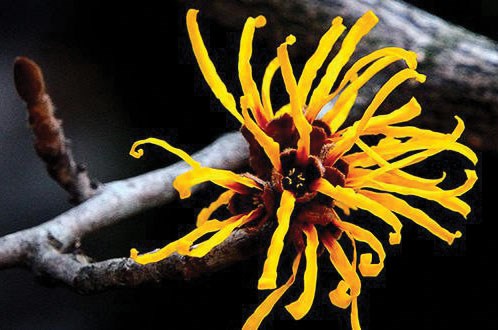I apologize for my absence on these pages. Like the seasons, the life of a garden columnist is cyclical and the past weeks have been time for reflection, moving a little slower and getting ready to re-awaken – just like a garden in winter.
I think we are all drawn to colour in the garden after a long winter and one of the first harbingers of spring to arrive in Squamish is the lovely hamamelis-x-intermedia, also commonly referred to as witch hazel.
Witch hazel is a shrub that, admittedly, is not a show stopper most of the year, but begins to shine in mid-winter when its abundance of spidery yellow-coloured (or sometimes red or orange) flowers cover the bare branches.
The flowers can be wonderfully scented so if you have the opportunity to get up close and personal with one I highly recommend it. People often say the scent reminds them of hyacinth or lilies, but I think it is an original scent all to its own.
Witch hazel has been used over the years for its medicinal qualities and is often made into an astringent used in treating skin irritations.
The two most popular varieties seen on the coast have to be hamamelis “Diane,” which has deep-red flowers and H. ‘”Jelena,” which has more coppery-orange-coloured blossoms. Both grow to about 10-feet tall and look fantastic in a woodland garden. I also like to situate witch hazel in front of an evergreen. When the flowers bloom along the bare branches with a backdrop of dark green the colours really pop.
There is also a Chinese witch hazel, H. mollis, which is a parent of Diane and Jelena. They sport delightful yellow blooms that are a little more elongated and have less of a twist than the above mentioned, but they are truly the most fragrant of all the witch hazels. They can also grow a bit larger to 20 feet.
Look for H. mollis “Pallida’” or H. mollis “Brevipetala” if you want fragrance.
Witch hazels are a deciduous shrub that can grow from 10 to 20 feet depending on what kind you choose. They like well-drained acidic soil and can be pruned to size, but are really lovely if you let them grow into their natural vase-like shape. If you do want to prune, make sure you do it after flowering or before the leaves start to open in the spring.
As I mentioned earlier, the witch hazel plays a supporting role in the garden as for most of the year it is fairly unremarkable. Its good to plant it with a mix of other shrubs and to under-plant it with flowering perennials and spring bulbs. My last tip is to plant it somewhere you pass by like a gate or a front entrance to truly enjoy it in its prime.



